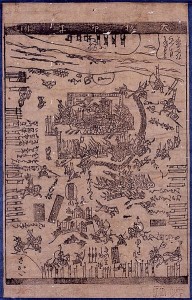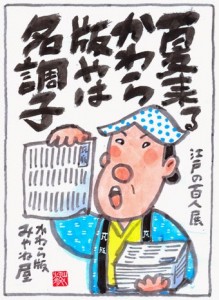The Kawaraban emerged during the Edo period of Japan (1603-1867). This was a time in which Japan was in a period of peace, political stability under military dictatorship (shogunate), and economic growth.
Though this sounds like it was already a great and smooth sailing time for Japan, being under the dictatorship of the shogunate had to have prompted some kind of small rebellion from citizens. This little “rebellion” was the Kawaraban.
The Kawaraban was a printed paper that reported to Japanese citizens newsworthy events such as: natural disasters, superstitious happenings, murders, and occasionally, political satire. The Kawaraban was printed in large quantities on cheap papers to keep costs down, and they were meant for shirt-term enjoyment. It was a commercially sold paper, published anonymously, and illegally published without government organization. What is interesting about this particular historical paper, is that it’s news was mostly done in illustrations and small pieces of writing. Typically, it was distributed as a ‘broadside’, just a sheet of paper with only one side.
During this period, the shogunate repeatedly tried to restrict printing for a mass audience, mostly aimed in an attempt to avoid rumors an political commentary. However, the system of restriction could not keep up with the number of prints spreading like wildfire in both rural and urban areas.
Remember those shows and movies where a character would stand at the side of the road next to a stack of papers holding a sheet yelling, “Extra, extra, read all about it”? This is pretty similar to how the Kawaraban was distributed back in the day. They were called “kawaraban uri”, which translate directly to “vendor of a kawaraban”.
There are jokes that vendors would make their living through selling Kawaraban just as the old newsboys did. He would stand at the side of the road or street with a a cloth or bandana tied around his head, a “hapi” coat draped through his arms, holding a withdrawn fan or chopstick to hit the paper he was holding to draw attention.
It’s amazing how with such prolific vendors of the Kawaraban, the government had such a hard time restricting the print! The cause though must be that the public was so curious and the need for news and entertainment was so strong, that the anonymous writers and distributors found a way around the system in order to continue distributions.



Leave a response